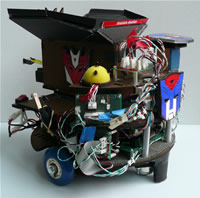ME218B
Welcome to Team Open Loop and our 218B robot shrine. To celebrate our momentous victory, we have assembled a report which documents our deepest and darkest secrets in robot construction.
Warning! This information is not for the weak at heart. Only proceed if you are willing to sacrifice many many many many hours of your life for Happy Fun Ball fame. And remember, with great power comes great responsibility….
Super Happy Fun Ball Overview
ME218B is the second in a 3 course mechatronics sequence taught at Stanford University. As is a long-standing tradition for the course, this B project revolved around designing a robot to play a game of "Happy Fun Ball" against an opponent robot. While a full detailed description of the game of Super Happy Fun Ball is available as a PDF, the essentials of the game are as follows:
- The game starts with a camera flash and lasts until 2 minutes have elapsed, or until one of the two robots has exhausted the supply of balls in its dispenser and carried on-board, whichever is less
- Happy Fun [nerf] Balls are requested by pushing a button under a dispenser. A maximum of one ball per second is dispensed. If balls are requested rapidly 5 times in succession, the rate at which they are dispensed will slow to once every 3 seconds, until a 10 second pause in requests elapses.
- Points are scored in one of 3 goals. Any ball in Goal 1 is 2 points. Any ball in Goal 2 is 3 points, and a yellow ball in Goal 3 is 4 points, a black ball in Goal 3 is 8 points. Balls left on the field at the end of the game are -1 point, regardless of color. To score, balls must pass under the beacon and between the posts of goals 1 and 2. To score, balls must be placed inside the box in front of goal 3.
- Goals and the dispenser are marked by different color lines of masking tape leading to each goal, and by an IR beacon with a known duty cycle above the goal. The duty cycles differ between goals, but do not differ between sides.
- The two playing fields are mirror images of one another.
- The robots must be battery powered and free from human intervention.
- Robots start in a pre-determined 'zone' of the field in a random orientation.
- Do not taunt Happy Fun Ball
